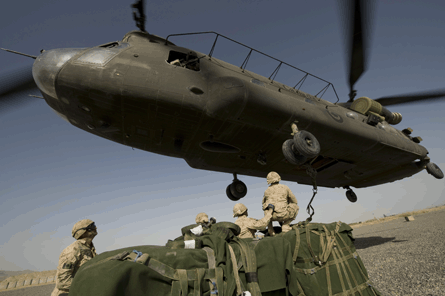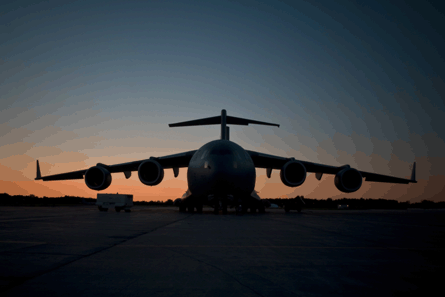To one Canadian legislator, no event symbolised the rising power of his country's military forces than a recent tour of Afghanistan by Minister of Defence Peter McKay.
In the same week in May McKay and his Washington DC equivalent - Secretary of Defense Robert Gates - separately visited troops and met commanders across Afghanistan.
According to US senator Hugh Segal, the timing of both tours was purely accidental. The Canadians were not even aware that Gates was coming, Segal says. Such secrecy by a US official came as no surprise in Ottawa. Gates's staff was observing standard security procedures.
But the remarkable fact about McKay's arrival is that it also came as a surprise to the US forces in Afghanistan, said Segal in his keynote address at the Cansec defence exhibition in Ottawa on 27 May.
 |
|---|
© Canadian Air Force |
For the first time in decades, a top Canadian government official could cross an ocean and tour a combat zone using all Canadian-owned equipment, Segal said. US forces were not told about the tour because McKay's troops did not need to ask for their help.
LANDMARK ACHIEVEMENT
To Segal, a Conservative party member and staunch supporter of higher military spending, this is a landmark achievement and a sign of the progress achieved since the arrival in Ottawa of a new government since 2006.
Prime Minister Stephen Harper's decision to approve the purchases of four Boeing C-17s and several used Boeing CH-47D Chinooks in 2007 - among several new aircraft acquisitions - made the secrecy of McKay's recent trip possible.
Those purchases provided an immediate boost to Canada's ability to project power over long distances and reversed more than a decade of stalled modernisation budgets. But the C-17s and used CH-47Ds were only the start.
Harper's administration has also signed a contract for 17 Lockheed Martin C-130J transports and announced plans to buy 16 new CH-47Fs. The latter remains in contract negotiations between the Department of National Defence (DND) and Boeing.
Moreover, the "Canada First Defence Strategy" unveiled last year proposes to spend $240 billion over the next 20 years to buy and maintain more new kit, including fighter, search and rescue and maritime patrol aircraft.
This sudden burst of procurement activity has clearly made its mark on the make-up of Cansec, which has grown from a relatively small affair to a sprawling complex, with three exhibit halls and 7,000 visitors.
The new government has changed the tone and substance of discussions about defence spending in Canada. However, a once-strong domestic industrial base has raised alarms that the recent contract awards bypasses Canadian companies.
McKay's secret visit to Kabul shows Canadian troops have gained a new level of operational independence. The question to some in the defence industry is whether Ottawa is sacrificing the long-term health of the industrial base.
Military spending has whip-sawed in Canada, from impoverishment in the 1970s to massive build-up in the 1980s.
 |
|---|
© Canadian Air Force |
"We've been saying consistently that the government should be applauded for its efforts to give the Canadian forces new equipment," says Tim Page, executive director of the Canadian Association of Defence and Security Industries (CADSI).
With the DND's recent decisions then to release billions of dollars to buy new fleets of airlifters and helicopters, acquisition officials seemed to embrace the initiative.
However, CADSI also recommends that "as you rebuild Canada's military, do so in a way that you build strategic industrial capability in Canada," Page says. "Investing in our military does not mean that you disinvest in the Canadian industrial base."
The rapid acquisition of the C-17s exemplifies the concerns within the industrial base. Although the DND managed to acquire the four C-17s rapidly, the $2 billion contract was not opened to competitive bidding. Instead of setting aside depot-level maintenance work for Canadian industry, Ottawa decided to outsource sustainment support to the US Air Force's depot system.
The fact that Boeing has met the terms of an industrial offset package comes as little consolation to CADSI's members, Page says. Boeing and Lockheed are required to each match the value of their contracts with offsets to local industry. That work can be applied across their entire portfolio of their US and international programmes.
"If you talk to Boeing and Lockheed - and I agree with them - they'll say they've done a great job of filling up the buckets on industrial and regional benefits," Page says.
"Our message to the government is that it's not simply the quantity of business that's being brought to Canada, but it's the quality of the business coming in to Canada. And in developing a defence industrial policy, we hope, the government will see that there are certain strategic capabilities that have a value in Canada that should be endemic to the Canadian industrial base."
Canada plans to complete three more procurements for military aircraft over the next decade. Canadian industry wants the three pending contract awards - for up to 17 fixed-wing search and rescue aircraft, 65 tactical fighters and a new fleet of medium-altitude, long-endurance unmanned aircraft systems - to set aside roles for domestic companies that could allow them to compete for similar work across the global supply chain.
"We sharpened our teeth on the C-17 and C-130J," Page says. "Now we're on to other procurements in air, as well as land and sea, and we hope that the lessons acquired over the last couple of years will play out into an industrial programme that builds capability and builds capacity in Canada in a way that frankly supports our role in the shared security of North America and contributes to the needs of our NATO allies, including the USA."
The DND has formed a next-generation fighter capability office to develop an acquisition strategy for replacing the Boeing CF-18 fleet starting in 2017.
Although Canada is a member of the nine-nation partnership producing the F-35, Boeing and Eurofighter are also respectively marketing the F/A-18E/F Super Hornet and Typhoon. However, industry's choice between the fighter jets is already clear through Canada's $9 billion economic stake in the F-35's supply chain.
CONTRACT HINT
The fixed-wing search and rescue contract, which has been in contention since 2002, may offer the first taste of the government's industrial policy. Competing aircraft the Alenia C-27J and EADS Casa C-295 remain in the competition's mix.
However, two Canada-based suppliers - Bombardier and Viking Air - also plan to participate in the competition. Bombardier is preparing a bid based on the Q400 turboprop. Viking Air is proposing a modernised Buffalo NG, with new Pratt & Whitney Canada PW150 engines, a new cockpit, composite fuselage structures and redesigned nacelle.
Source: Flight International























